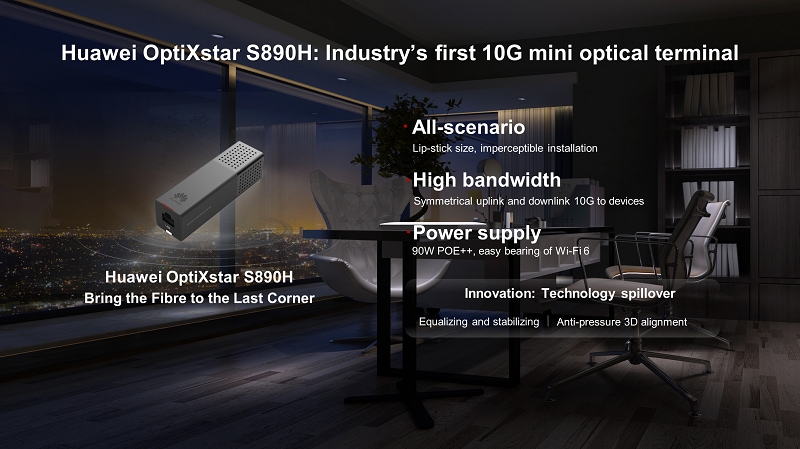[Shenzhen, China, September 27, 2021] At HUAWEI CONNECT 2021, Huawei launched four innovative optical infrastructure products, which are set to accelerate digital transformation in various industries such as electric power, oil and gas, coal mining, and manufacturing. With industry-leading optical technologies, Huawei has developed the industry’s first Optical Transport Network (OTN) communication product — hybrid OTN (H-OTN) — to support Native Hard Pipes (NHPs). Huawei also revealed a brand-new series Huawei OptiXsense, an innovative intrinsically safe industrial optical terminal, and a 10G mini optical terminal.
“Digital transformation is now shifting from office scenarios to core production scenarios, which poses higher requirements on digital infrastructure,” said Richard Jin, President of Huawei Optical Business Product Line. “This requires optical communication networks to be more reliable and secure, and optical sensing technology to provide higher identification precision for optical services. As a leader in the optical industry, Huawei has been continuously investing in basic research and technical innovation, and is committed to building ubiquitous optical connections. With its leading optical products and solutions, Huawei will enable various industries to dive into digital.”
H-OTN supporting NHPs leads the revolution of safe production networks
As industries undergo digital transformation, many independent networks, such as video networks and Internet of Things (IoT), have emerged. With the constant rollout of new services, more networks are being constructed, which brings a new avenue of challenges to network operation and management (O&M). Against this backdrop, Huawei proposed a groundbreaking network solution based on NHPs. This solution uses the Optical Scanning Unit (OSU) to carry different services in a unified manner while ensuring physical isolation between services.
During HUAWEI CONNECT 2021, Huawei launched the industry’s first optical communication product H-OTN to support NHPs. H-OTN integrates OTN and Optical Line Termination (OLT) device capabilities for the first time and implements end-to-end hard pipes from access networks to Wide Area Networks (WANs), guaranteeing the absolute security of core services and slashing latency by over 60%.

New Huawei OptiXsense improves the inspection efficiency of digital pipelines
Oil and gas pipelines are the lifelines of national energy transmission. As pipeline mileage increases, a new “manual + automatic” inspection model is needed to keep up with the necessary inspections. To meet this requirement, Huawei has applied cutting-edge optical technologies to the optical fiber sensing field and developed a new intelligent fiber sensing product — Huawei OptiXsense. This product performs fiber vibration sensing with superior identification accuracy and is primed to be widely used in oil and gas pipeline scenarios.
Core features of Huawei OptiXsense include:
- Enhanced signal collection: The enhanced-Optical Digital Signal Processor (e-oDSP) module has a super algorithm that corrects blind spot errors, raising the effective signal collection rate to 99.9% and achieving zero false negatives.
- Accurate identification: Huawei has developed the ingenious vibration wave identification engine. Its 32-dimensional vibration wave analysis algorithm increases the event recognition accuracy to 97%.
- Fast self-learning: Unique sample iteration simulation supports fast iteration of numerous new scenario samples (1000 samples per day), enhancing sensing and warning accuracy.
Huawei OptiXsense has the capability to dive deep into the digital inspection of oil and gas pipelines. By enabling full-process automation covering detection, analysis, diagnosis, and warning, it can help achieve zero false negatives and low false positives and realize unattended intelligent inspection.

Industry’s first intrinsically safe industrial optical terminal ensures security
For scenarios with high security requirements, such as mining and chemical engineering, Huawei has released the intrinsically safe industrial optical terminal — Huawei OptiXstar 2.0 — to carry video backhaul, sensing, and mechanical control services. Compared with products from the previous generation, Huawei OptiXstar 2.0 provides intrinsic safety, service security, and easy deployment for network devices.
Core features of Huawei OptiXstar 2.0 include:
- Intrinsic security: An innovative precision circuit design auxiliary algorithm has been introduced to suppress circuit loop energy, satisfying the intrinsic safety requirements and eliminating the need for underground explosion-proof boxes.
- Service security: Ultra-intelligent detection algorithm 2.0 enables network switchover within 30 ms when a link or port fails, ensuring zero service interruption.
- Easy deployment: The device is installed in an intrinsically safe box and weighs about 8 kg, with a volume one fifth of the industry average. It can be installed underground by a single person.

Unique 10G mini optical terminal brings fiber to the last corners of campuses
As the all-optical campus network become a new symbol of the next-generation smart campus, Huawei is dedicated to offering the optimal Campus OptiX solution to industry customers. To address problems that have long existed in campus networks, including poor installation environment and limited power supply, Huawei has officially launched the industry’s first 10G mini optical terminal — Huawei OptiXstar S890H that supports full-scenario Wi-Fi 6, covering every base of campus needs.
The new Huawei OptiXstar S890H features:
- All-scenario: Based on Huawei-patented equalizing and stabilizing technology, the product volume is only one fifth of the industry average. In addition, it can be installed with Wi-Fi APs, enabling imperceptible installation.
- High bandwidth: With the XGS PON technology, the device boasts symmetric upstream and downstream bandwidths of 10 Gbit/s, providing 10G to terminals and meeting Wi-Fi 6 data backhaul requirements.
- Power supply: With a built-in patented photoelectric composite connector, the power loss and optical path insertion loss of the device is 50% and 67% lower than the industry average, respectively. Moreover, it provides up to 90 W power supply for Wi-Fi 6.

PR Archives: Latest, By Company, By Date